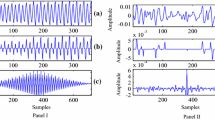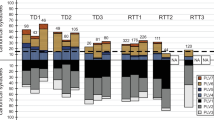Abstract
There is preliminary evidence that infant siblings of children with Autism Spectrum Disorder (ASD) have an atypical pattern of cry, characterized by higher fundamental frequency and increased dysphonation. This prospective study collected multiple cry samples of 12-month old siblings of children with ASD (n = 22, ‘high-risk’ group) and 12-month olds with no family history of ASD (n = 27, ‘low risk’ group). While there was no difference between groups in the fundamental frequency or degree of phonation of the cry samples, the duration of each cry unit was significantly shorter in the high-risk siblings (p < .05). The six infant siblings who received a diagnosis of ASD at age two had amongst the shortest recorded cry durations.

Similar content being viewed by others
References
Ainsworth, M. D. S., Blehar, M. C., Waters, C. S., & Wall, S. (1978). Patterns of attachment: A psychological study of the strange situation. Oxford: Lawrence Erlbaum.
Ainsworth, M. D. S., & Wittig, B. A. (1969). Attachment and the exploratory behaviour of one-year-olds in a strange situation. In B. M. Foss (Ed.), Determinants of infant behavior (Vol. 4, pp. 113–136). London: Methuen.
American Psychiatric Association (2000). Diagnostic and statistical manual of mental disorders (4th ed.). Washington.
American Psychiatric Association (2013). Diagnostic and statistical manual of mental disorders (DSM-5). Washington, DC: American Psychiatric Pub.
Bailey, A., Luthert, P., Dean, A., Harding, B., Janota, I., Montgomery, M., et al. (1998). A clinicopathological study of autism. Brain, 121(5), 889–905.
Boersma, P., & Weenink, D. (2005). Praat: Doing phonetics by computer (version 5.0.06) PC software. http://www.praat.org.
Boersma, P., & Weenink, D. (2013). Praat: Doing phonetics by computer. http://www.fon.hum.uva.nl/praat.
Deliyski, D. D., Shaw, H. S., & Evans, M. K. (2005). Adverse effects of environmental noise on acoustic voice quality measurements. Journal of Voice, 19(1), 15–28.
Esposito, G., del Carmen Rostagno, M., Venuti, P., Haltigan, J. D., & Messinger, D. S. (2014). Brief report: Atypical expression of distress during the separation phase of the strange situation procedure in infant siblings at high risk for ASD. Journal of Autism and Developmental Disorders, 44(4), 975–980.
Esposito, G., Nakazawa, J., Ogawa, S., Stival, R., Putnick, D. L., & Bornstein, M. H. (2015). Using infrared thermography to assess emotional responses to infants. Early Child Development and Care, 185(3), 438–447.
Esposito, G., & Venuti, P. (2008). How is crying perceived in children with autistic spectrum disorder? Research in Autism Spectrum Disorders, 2, 371–384.
Esposito, G., & Venuti, P. (2009). Comparative analysis of crying in children with autism, developmental delays, and typical development. Focus Autism and Other Developmental Disabilities, 24, 240–247.
Esposito, G., & Venuti, P. (2010). Developmental changes in the fundamental frequency (f0) of infants’ cries: A study of children with autism spectrum disorder. Early Child Development and Care, 180, 1093–1102.
Esposito, G., Venuti, P., & Bornstein, M. H. (2011). Assessment of distress in young children: A comparison of autistic disorder, developmental delay, and typical development. Research in Autism Spectrum Disorders, 5, 1510–1516.
Etz, T., Reetz, H., Wegener, C., & Bahlmann, F. (2014). Infant cry reliability: Acoustic homogeneity of spontaneous cries and pain-induced cries. Speech Communication, 58, 91–100.
Hus, V., & Lord, C. (2014). The autism diagnostic observation schedule, module 4: Revised algorithm and standardized severity scores. Journal of autism and developmental disorders, 44(8), 1996–2012.
LaGasse, L. L., Neal, A. R., & Lester, B. M. (2005). Assessment of infant cry: Acoustic cry analysis and parental perception. Mental Retardation and Developmental Disabilities Research Reviews, 11, 83–93.
Lin, H., & Green, J. (2007). Effects of posture on newborn crying. Infancy, 11, 175–189.
Lord, C., Risi, S., Lambrecht, L., Cook, E. H. Jr., Leventhal, B. L., DiLavore, P. C., et al. (2000). The autism diagnostic observation schedule—generic: A standard measure of social and communication deficits associated with the spectrum of autism. Journal of Autism and Developmental Disorders, 30, 205–223.
Michelsson, K., Eklund, K., Leppanen, P., & Lyytinen, H. (2002). Cry characteristics of 172 healthy 1-to 7-day-old infants. Folia Phoniatrica et Logopaedica, 54, 190–200.
Mullen, E. (1995). Mullen Scales of Early Learning. AGS Edition. Circle Pines: American Guidance Service. Inc.
Oller, D. K., Niyogi, P., Gray, S., Richards, J. A., Gilkerson, J., et al. (2010). Automated vocal analysis of naturalistic recordings from children with autism, language delay, and typical development. Proceedings of the National Academy of Sciences of the United States of America, 107, 13354–13359
Ozonoff, S., Young, G. S., Carter, A., Messinger, D., Yirmiya, N., Zwaigenbaum, L., et al. (2011). Recurrence risk for autism spectrum disorders: A baby siblings research consortium study. Pediatrics, 128, 488–495.
Rodier, P. M. (2002). Converging evidence for brain stem injury in autism. Development and Psychopathology, 14(3), 537–557.
Rodier, P. M., Ingram, J. L., Tisdale, B., Nelson, S., & Romano, J. (1996). Embryological origin for autism: developmental anomalies of the cranial nerve motor nuclei. Journal of Comparative Neurology, 370(2), 247–261.
Santos, J. F., Brosh, N., Falk, T. H., Zwaigenbaum, L., Bryson, S. E., Roberts, W., et al. (2013). Very early detection of autism spectrum disorders based on acoustic analysis of pre-verbal vocalizations of 18-month old toddlers. In Acoustics, Speech and Signal Processing (ICASSP), 2013, IEEE International Conference (pp. 7567–7571). IEEE.
Schoen, E., Paul, R., & Chawarska, K. (2011). Phonology and vocal behavior in toddlers with autism spectrum disorders. Autism Research, 4, 177–188.
Sheinkopf, S. J., Iverson, J. M., Rinaldi, M. L., & Lester, B. M. (2012). Atypical cry acoustics in 6-month-old infants at risk for autism spectrum disorder. Autism Research, 5(5), 331–339.
Sheinkopf, S. J., Mundy, P., Oller, D. K., & Steffens, M. (2000). Vocal atypicalities of preverbal autistic children. Journal of Autism and Developmental Disorders, 30, 345–354.
Stewart, A. M., Lewis, G. F., Heilman, K. J., Davila, M. I., Coleman, D. D., Aylward, S. A., et al. (2013). The covariation of acoustic features of infant cries and autonomic state. Physiology & behavior, 120, 203–210.
Unwin, L. M., Maybery, M. T., Murphy, A., Lilje, W., Bellesini, M., Hunt, A. M., et al. (2016). A prospective ultrasound study of prenatal growth in infant siblings of children with autism. Autism Research, 9(2), 210–216
Venuti, P., Caria, A., Esposito, G., de Pisapia, N., Bornstein, M. H., & de Falco, S. (2012). Differential brain responses to cries of infants with autistic disorder and typical development: An fMRI study. Research in Developmental Disabilities, 33(6), 2255–2264.
Venuti, P., Esposito, G., & Giusti, Z. (2004). A qualitative analysis of crying and vocal distress in children with autism. Journal of Intellectual Disability Research, 48, 338–338.
Wechsler, D. (1999). Wechsler abbreviated scale of intelligence. San Antonio: Psychological Corporation.
Wechsler, D. (2003). Wechsler intelligence scale for children (4th edn.). San Antonio: Psychological Corporation.
Werling, D. M., & Geschwind, D. H. (2013). Sex differences in autism spectrum disorders. Current Opinion in Neurology, 26, 146.
Woods, J. J., & Wetherby, A. M. (2003). Early identification of and intervention for infants and toddlers who are at risk for autism spectrum disorder. Language, Speech, and Hearing Services in Schools, 34, 180–193.
Young, R. L. (2007). Autism detection in early childhood (ADEC) manual. Camberwel: ACER Press
Acknowledgments
This research was funded by a Project Grant (APP1003424) and Senior Research Fellowship to AJOW (APP1077966) from the National Health and Medical Research Council (NHMRC). The authors would like to acknowledge the participating families who generously donated their time to this study. MH is funded by an NHMRC Practitioner Fellowship (1058935). The funders had no role in study design, data collection and analysis, decision to publish, or preparation of the manuscript.
Author Contributions
LMU participated in study design, acquisition of the data, performed statistical analyses and interpretation of data, and co-ordinated, drafted and revised the manuscript. IB was involved in coding, analysing and interpreting the data. MTM was involved in interpretation of data and helped to draft and critically edit the manuscript. VR helped to interpret the data and was involved in critically editing the manuscript for important intellectual content. NC provided helpful feedback on the manuscript and participated in interpreting data. CD was involved in study design and revising the manuscript. MH was involved in acquisition of funding, study design and participated in editing and reviewing the manuscript. AJOW was involved in acquisition of funding, study design, interpretation of data, statistical analyses and helped to draft and revise the manuscript. All authors have given final approval of the version to be published.
Author information
Authors and Affiliations
Corresponding author
Ethics declarations
Conflict of interest
The authors declare that they have no conflict of interest.
Ethical Approval
All procedures performed in studies involving human participants were in accordance with the ethical standards of the institutional and/or national research committee and with the 1964 Helsinki declaration and its later amendments or comparable ethical standards.
Rights and permissions
About this article
Cite this article
Unwin, L.M., Bruz, I., Maybery, M.T. et al. Acoustic Properties of Cries in 12-Month Old Infants at High-Risk of Autism Spectrum Disorder. J Autism Dev Disord 47, 2108–2119 (2017). https://doi.org/10.1007/s10803-017-3119-z
Published:
Issue Date:
DOI: https://doi.org/10.1007/s10803-017-3119-z




